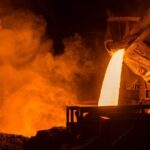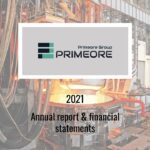Addressing decarbonization of steel industry in Europe
April 20, 2021
Decarbonization of the steel industry is a global challenge which the sector is facing in context of regulatory constrains and public pressure purposed to decrease carbon emissions or even achieve carbon neutrality within relatively short period of time. There is a bunch of solutions currently implemented and tested within the industry, however the problem to achieve the carbon emissions goal still remains complex and tricky
Decarbonization of the steel industry is a global challenge which the sector is facing in context of regulatory constrains and public pressure purposed to decrease carbon emissions or even achieve carbon neutrality within relatively short period of time. There is a bunch of solutions currently implemented and tested within the industry, however the problem to achieve the carbon emissions goal still remains complex and tricky
Steel plays a vital role in the life of a modern society. Among with some other materials steel is one of the most important materials people encounter in their day-to-day life. Most of the objects around us which make our life either comfortable or better or safer are made with application of steel. Cars and machinery, houses and pipelines, equipment and cutlery, just to name a few, are all made with use of steel.
It’s not a surprise that for centuries and especially during the last couple or three decades substitution of steel is being invincibly evolved, however, it’s hard to say about considerable diminishing of demand for steel. Quite contrary to that the demand for steel is growing and it seems that it shall not substantially – if at all – be decreasing in the foreseeable future as the spectrum of technically or economically feasible and available substitutes is not at all abundant.
According to some data the production of steel by the year 2050 shall increase for 14 million metric tons as compared with the year 2019 and shall reach 1.887 billion metric tons.
At the same time steel industry – quite unsurprisingly – is one of the largest CO2 industrial emitters and thus is facing an increasing regulatory and public pressure to manage CO2 emission problem and to reach CO2 neutrality in European arrangements context by the year 2050. According to some research up till the recent time production of every ton of steel were resulting in emission of 1.82 tons of CO2 which is definitely a lot.
Taking into account the pretty huge financing necessary to implement arrangements to address CO2 emissions and long investment cycles inherent to the industry the question about the alternative ways to proceed with decarbonization of the industry becomes vitally important and need to be carefully and wisely approached.
From technical perspective CO2 is being formed during melting of iron ore – used mostly as iron oxide – by heating it with carbon whereon CO2 is being formed as a by-product of such process:
Fe2O3 + 3CO → 2Fe + 3CO2
This process is being applied majorly at integrated steel making facilities which dominate the steel industry at the time being what thereby puts the steel industry into the group of the largest industrial CO2 emitters.
According to McKinsey & Company research 14 percent of steel companies’ value is at risk if they are unable to decrease their environmental impact. Such influence shall be mainly caused by increase of carbon emission prices
According to McKinsey & Company research 14 percent of steel companies’ value is at risk if they are unable to decrease their environmental impact. Such influence shall be mainly caused by increase of carbon emission prices
While there is a bunch of approaches to reducing the steel industry CO2 emissions – which shall be mentioned below – the choose of the technology depends upon various factors or various nature such for example as availability and therefore price of certain resources, applicable legislative and safety regulations, carbon prices etc.
It is also necessary to note that decrease of CO2 emissions in steel industry is to be considered as a complex outcome where not only direct CO2 emission is to be taken into account – for example CO2 emitted during the melting iron ore – but also emission having place during the manufacture of other inputs necessary for steel manufacturing process, for example electricity or hydrogen.
With regard to strategies being considered by European steel producers – which predominately use blast furnace (BF)/basic oxygen furnace (BOF) technology and to certain extent electric arc furnace (EAF) technology as their main manufacturing methods – the following are to be mentioned beforehand.
There is quite a number of strategies and technologies which are being implemented and tested by steel manufacturers nowadays, however not all of them may allow to reach carbon neutrality equilibrium. This article shall not examine in details those approaches which are not allowing to reach the said goal but focus only on those ones which may allow to do so.
Increase of use of EAF technology. The technology envisions use of steel scrap as main component to produce steel. While this technology may allow to meet carbon neutrality challenge to some maximum extent the feasibility of this technology shall depend upon availability of high-quality steel scrap and commercially viable green electricity. The question about electricity emerges due to the fact that we need to eliminate carbon emissions in all industries providing inputs for steel sector including power generating sector.
Optimization of EAF technology with direct reduce iron (DRI). When the high-quality steel scrap is scarce resource EAF may use DRI as a component to be used together with steel scrap to produce steel of required quality. However, DRI technology requires extensive use of natural gas resources so it might be feasible for regions with available vast supply of natural gas and affordable natural gas prices.
Implementing DRI and EAF technologies using hydrogen. Use of hydrogen in course of DRI manufacturing allows to reduce – if not to fully eliminate – CO2 emission and at the same time does not require use of substantial quantities of natural gas what eliminates the problem described in the above solution.
The major issue with this technology is a manufacturing of hydrogen. The hydrogen may be divided into two categories, the fist is so-called grey and green hydrogen. Grey hydrogen is produced by steam methane reforming which in its tern causes CO2 emission what is not allowing to reach all-in-all carbon neutrality. On the other hand, production of green hydrogen – what is being produced via electrolysis of water – is the only carbon free option which at the same time is energy intensive.
In case alternative renewable energy resources – what shall be meaning that such hydrogen production is entirely carbon-free – are used then the question of the price of electricity shall currently be high and seemingly not feasible.
However, with the lapse of time the situation is changing and economical feasibility of using green hydrogen in DRI production shall be pirouetting around price of green energy – which is declining and is expected to continue declining, electrolyzers efficiency – which is improving, and cost of CO2 emissions – that are increasing.
Except of operational constrains affecting on the efficiency of use of more carbon friendly technologies and methods, implementation of the projects shall depend upon availability of financing resources – and investment budgets shall be quire impressive – and eventual government support of such projects
Except of operational constrains affecting on the efficiency of use of more carbon friendly technologies and methods, implementation of the projects shall depend upon availability of financing resources – and investment budgets shall be quire impressive – and eventual government support of such projects
The turning point for green hydrogen prices is expected to happen somewhat in the year 2030. By that time the price of green hydrogen, which currently is about two times higher than grey hydrogen price, shall become equal to grey hydrogen and shall further go below grey hydrogen price.
The operational efficiency and competitiveness assessment outlined above does not take into consideration the CAPEX which shall be required to implement the transition to new more carbon emissions friendly technologies in steel and related industries which are expected to be quite substantial.
In reality – nevertheless that hydrogen-based steel making seems to be the most appropriate method for Europe – the transition shall be multi-dimensional or in other words finally an overall solution shall be a mix of technologies whereon implementation of one or another option shall depend upon a number of individual particularities and peculiarities of a plant or a region or both; in the upshot, we do not need exclusively one – even if it is the most effective solution from CO2 emissions reducing standpoint – solution in order to achieve the desirable carbon emission reduction goal.
In case of any queries or for obtaining further information please contact office.poland@primeore.eu


